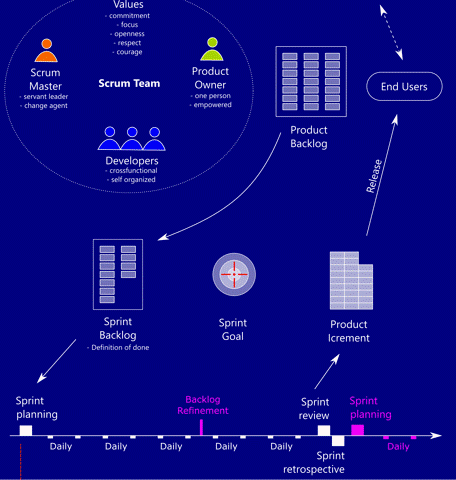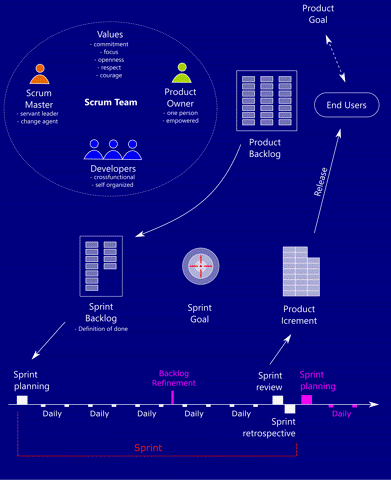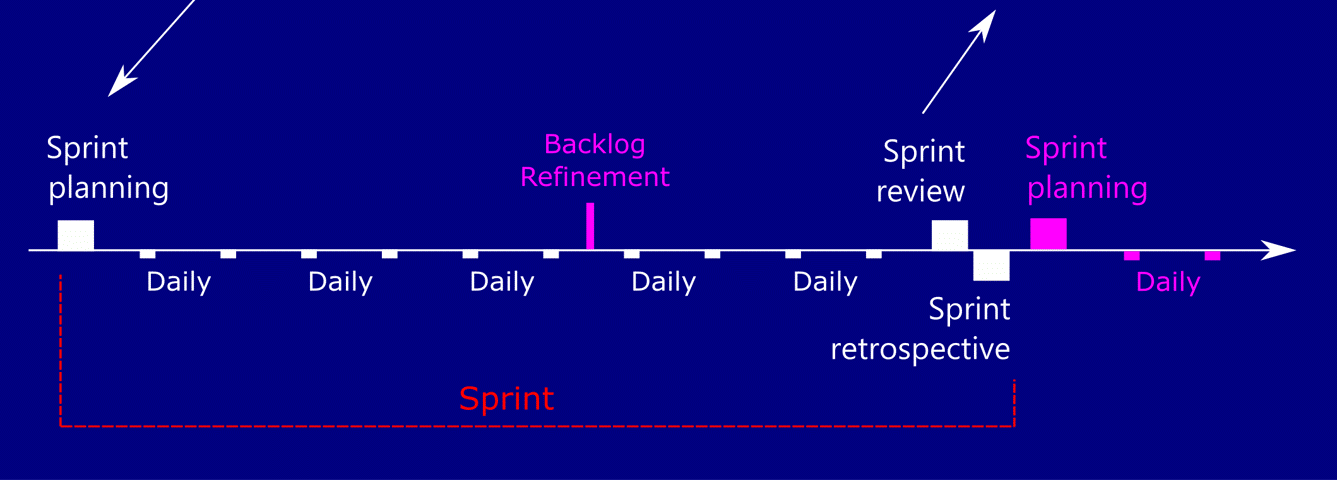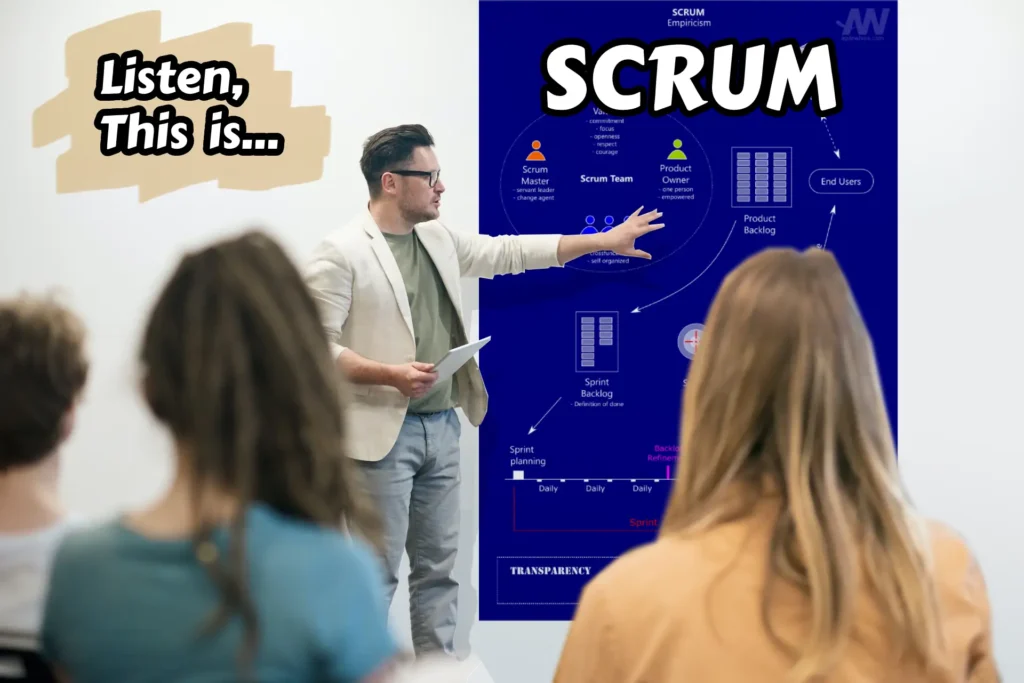When working in an agile organization a scrum master ensures that scrum is understood and used. Especially when developers or other employees are new to the scrum framework we have to be able to teach them about scrum to the point that they understand how to work in this agile culture. You can have a different approach to this subject, but from my experience, there is a perspective that helps to understand the whole concept effectively.
Teach scrum framework by making a graphic narrated presentation, emphasizing scrum pillars and incremental product building in a business context. Incremental delivery in combination with inspection and adaptation enabled by transparency is the key to understanding how we work and what for. Every other aspect of scrum is important and should be worked upon but in many cases, they are complementary to pillars and to production cycles.
After all, ensuring that everyone understands the framework is one of the ways a scrum master supports the organization. We should have an effective way of teaching about scrum.
How to present the scrum framework?
Draw.
If you create the framework piece by piece before your colleagues’ eyes it’s more likely they will pay attention to every aspect of it. While you draw you can focus on parts that require more in-depth explanation. You can add whatever you want, you can make notes on the sketch, and make significant connections of parts that tightly correspond to each other. You can add descriptions of who plays which role in your organization.
Presenting by drawing is the most superior way of all.
There is one problem with drawing – not everyone draws in a clear and easy-to-read way.
If you are not so comfortable with drawing you can make an “interactive” presentation. Make slides and make notes on top of them, connect parts, and sketch other things you consider necessary. This way you can have the best of both worlds. You have cool, clean clear pictures and you can enrich them with individual notes.
I advise you to start this way, you can use my slides to teach about scrum.
I don’t advise leaving teaching to pure conversation. Without any pictures, it can be difficult to explain different parts of the framework. It is hard to imagine how it all works without observing it in the real world and without even having a picture explaining it.
How to present scrum framework exactly?
Give business context.
In the beginning, tell a story about an investor in need of developing a solution. It will give relevant business context.
The investor – let’s call him Fred, hired a different firm before, but the problem was that after giving the requirements he didn’t have any influence on the development. After a couple of months got a product that didn’t exactly match his expectations.
Add some narration – a specific idea for a solution.
This way you will grab your listeners’ attention.
For example, an app that allows a user to take a picture and swap his or her head for an animal one, and then rate which blue cheese is more stinky 😛

Depending on your audience you can consider making the idea funny like the one above, but remember to keep the presentation on track.
For this article let’s take a more serious example: an online library that has professional books and newspapers.

During the whole presentation, you will remind everyone of Fred and his idea. Thanks to this your audience will be focused and the presentation will be easier to remember. You can find out more about presentation skills here.
For business context also the user would be important to mention. Let’s say that a typical user of this online library would be a John Smith who needs to read his professional solicitor’s magazine, and likes to read his hobby fashion magazine.
Present the framework by describing the process of creating value.
This investor – Fred, comes to our firm and signs a contract for development – he is clearly one of the key stakeholders because he is paying for the job (more on stakeholders Here).
Below is an example of how you can show a graphic representation of the scrum framework, how to describe every part in a brief, and how to draw connections on top of it.
- The project starts when our Product Owner works with stakeholders on the core concept of the library application. From complex studies involving the end users’ most relevant needs, a product goal emerges. The Product Owner crafts the Product Backlog. The product backlog should contain items that address the development of all known requirements including MVP – a minimum-value product. Users will be able to use MVP and also pay for it already. The most basic version of the library must as soon as possible go to market.

- PO takes the product backlog and refines the most important items with the developers. Having a visible product backlog is the first symptom of transparency which is critical to developing a solution in an agile way. And by a solution – I mean a cool library app.
- Everyone has a specific role in the process and should stick to it. At this stage, it is good to describe the key features and responsibilities of each role. It should also be marked on the slides.
Scrum master keeps an eye on the scrum process, and coaches everyone on how to work in an agile way. He is a servant leader and a change agent.
The product owner optimizes the work of the developers by keeping the product backlog organized and well-described. He or she is empowered in the organization and is accountable as an individual.
Developers produce the solution, they are a crossfunctional and self-organized team.
Altogether they form the scrum team.
You can say a lot more about every role in the scrum team, but if you are doing a presentation about the framework as a whole – these are the most important ones. You can dive deeper into every role on a different occasion.
- The scrum team plans the sprint during the sprint planning meeting. They craft a sprint backlog and commit to a sprint goal. The PO and the developers must agree on the scope of the sprint and on the definition of done that describes the state in which the increment will be in at the end of the sprint. If you are a scrum master, you can find out more about supporting the team during planning here.

- The team develops the product during the sprint. Every day there is held a short ceremony called the daily scrum. It has only one purpose – to inspect whether the team is on the right track to achieve the sprint goal and adapt to potential risks. The team meets every day but it’s a short 15-minute or less meeting, only for the developers.
The sprint has a fixed duration – you should point out how many days it lasts in your organization.
- The sprint outcome is reviewed at the end of the sprint – at a Sprint review meeting. Key stakeholders attend the meeting as they are the source of valuable feedback. The developers present the increment and thereby provide the transparency needed for inspection of whether the scrum team is on the right track to achieve the product goal. Usually, the scrum master facilitates the meeting, you can find out more about it here. The product increment is inspected whether it satisfies the stakeholder’s expectations and the end users’ needs. If there are any circumstances that can alter the product goal, the priority of the features, or any other thing regarding the product – a discussion is held about how to adapt the development to those circumstances. The sprint review is the most important meeting in scrum. The transparent presentation of the increment enables the inspection of the product and its development adaptation.
The outcome of the sprint should be a product increment that is ready for a potential release. In our case – a library, full of books and magazines.
The product owner decides whether to release the ready product increment or not. Items that are not done go back to the product backlog for further refinement, planning, and development.
- The last ceremony is a sprint retrospective. During this meeting, the team inspects the effectiveness of the sprint regarding the processes, interactions, and tools. The scrum team discusses the way they work. If they find ways to do better – they adapt the processes.
The scrum values are often discussed in the retrospective meeting. The lack of openness, respect, and courage often results in a lack of trust among the team members. When there is no trust – the team can have trouble providing necessary transparency and therefore it is impossible to inspect the work and adapt for better effectiveness.
- During the sprint, there is a meeting called backlog refinement. It is a time when PO discusses with the team what the next sprint scope should be or details about the planned scope. Developers can discuss ways to implement the requirements. You could say that it is the next sprint planning preparation.

- After the end of the sprint – the next sprint begins. The next planning is the adaptation of the initial plan to the circumstances that were discussed during the refinement, review, and retrospective meetings.
- After a quick explanation of how scrum works, it is time to sum it all up and reveal that scrum pillars are at the heart of it all.
Every artifact in scrum is transparent so it can be inspected.
Every ceremony in scrum is an opportunity to inspect and adapt.
The basis of knowledge about the scrum framework is understanding that it is designed to conduct the inspection and adaptation process as often as possible. Only then we are able to provide valuable products to end users.

Why scrum pillars are so important in scrum?
Scrum pillars are transparency, inspection, and adaptation.
As you can see every ceremony’s purpose is to inspect and adapt: the product, team’s effectiveness, plan toward sprint goal, team’s health, plan toward product goal…
That is what scrum is all about – to be aware of what we are doing and whether is it on the right track. To be aware of the constantly changing business environment. To have a cyclical possibility to change the course of our actions in order to make the most valuable product for the users, because providing the best possible value is the purpose we work for.
Why is incremental development so important in scrum?
Incremental development lets you:
- provide value fast
- get fast feedback
- quickly adapt to dynamic market conditions
- quickly detect bugs
- quickly collect revenue and fund development
In addition, resetting ourselves, again and again, is in our nature. Every night we go to sleep so we can wake up fresh in the morning. Every weekend we chill out after a busy week and we rest before another one. It is only natural to work this way. We can start the work and then end it after a few days with a working piece of software developed. What’s done is done – we can rest and focus on the development of another feature.
Choose the presentation’s level of detail
The way I described the scrum framework above is an obvious simplification. You can clearly say much more about every aspect of it and present a much more detailed view of the scrum.
You must match the degree of complexity of your presentation to your listener.
If you are just describing the scrum to someone who will work in an agile organization but won’t play any role in a scrum team then this level of generality would probably do fine.
If you are training someone to be a product owner or a developer then you should focus on how exactly this role is affected by the scrum framework. This general presentation is only an introduction.
If you are teaching someone to be a scrum master – it is just the tip of the iceberg, a warmup that leads to many meetings and workshops full of real-life examples and exercises. But you can use this material as a basis for discussion and training.
Download the scrum framework poster
Here you can download my scrum framework poster and use it for sharing knowledge about scrum.
It would be great to give me credit and link to our site, thanks 😉
In conclusion
You should pick a work management system depending on your team’s needs. Don’t be a scrum evangelist. I deliberately pointed out that it is all about the scrum pillars so you can get the main idea or pass it on this way. If your teams’ can take advantage of it – teach them well and use it for better efficiency. If you have people working with the team or around it – teach them this general idea. This is one way a scrum master can support an agile organization – to make sure that everyone understands the framework and uses it accordingly.






